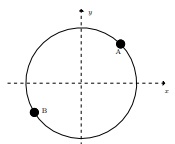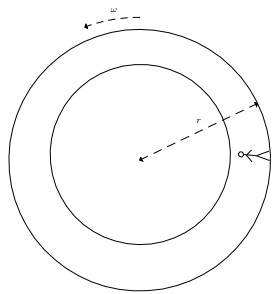Assignment:
Problem 1.
A) Show that the length of the vector rˆ = cos (θ) xˆ+ sin(θ) yˆ is 1.
B) Show that the length of θˆ= -sinθ xˆ + cos θ yˆ is 1.
C) Show that rˆ and θˆ are perpendicular.
D) Show that rˆ× θˆ= zˆ.
E) Sketch rˆ and θˆ at the points labeled A and B in the diagram below

Problem 2. Consider an object with a position vector given by r→ = (0.4m) cos (π/2 - (3/s) t) xˆ+ (0.4m) sin(π/2 - (3/s) t) yˆ
A) What is the position of the object at time t = 0.
B) Looking down on the x-y plane, is this object moving counterclockwise or clockwise?
C) Find the velocity of this object. Express your answer using both using Cartesian coordinate unit vectors and in terms of rˆ and/or θˆ.
D) Find the speed of the object.
E) Find the acceleration of this object. Express your answer using both using Cartesian coordinate unit vectors and in terms of rˆ and/or θˆ.
F) Find the magnitude of the acceleration of this object.
Problem 3. Consider an object with a position vector given by r~ = -r sin(ω t) xˆ+ r cos (ω t) yˆassume that r and ω are constant and positive.
A) Does this position vector represent motion on a circle? Justify your answer.
B) Find the speed of the object.
Problem 4. A car traveling with a speed of 50 mi/hr barely loses contact with the ground as it drives over the top of a circular hill. Find the radius of the hill.
Problem 5. A person of mass 100 kg rides in a Ferris wheel of radius 30 m. The Ferris wheel has a constant rotation rate (ω) of 0.3 rad/s. The motion of the Ferris wheel compartment is such that the person is always upright.
A) Find the normal force that the seat of the compartment exerts on the person at the top of the circular path traced out by the wheel.
B) Find the normal force that the seat of the compartment exerts on the person at the bottom of the circular path traced out by the wheel.
Problem 6. Find the number of rotations/day that a space station of radius 20,000 m must make if people standing on the outer rim of the space station experience a normal force of the same size that they would feel on earth while standing on the ground.

Problem 7. A ball of mass m = 0.5kg undergoes uniform circular motion in a horizontal plane while hanging at the end of a string of length 0.8 m. The string makes an angle of θ = 30? with the vertical.
A) Find the tension in the string.
B) Find the speed of the ball.
C) What would be the tension in the string if θ = 90??
Problem 8. A ball of mass 0.3 kg at the end of a rigid rod is undergoing circular motion in a circle of radius 0.5 m. The angular motion of the ball is described by the function, θ = A + B t2 - C t4 where
A = π/3 B = 3 rad/s2 C = 2 rad/s4
A) Find the angular speed (ω) as a function of time.
B) Find the angular acceleration (α) as a function of time.
C) Find the net force on the ball at time t = 3 s.
Problem 9. A block of mass 1 kg is on a turntable 0.5 m from the center of the turntable. The turntable starts from rest and has a constant angular acceleration of 0.2 rad/s2. The coefficient of static friction between the turntable and the block is 0.6.
A) Find the angular speed of the turntable as a function of time.
B) Find the radial and tangential components of the acceleration of the block as a function of time.
C) Find the radial and tangential components of the net force on the block as a function of time.
D) What is the maximum force that static friction can provide on the block?
E) When does the block start to slip?
F) How many rotations has the block gone through before it starts to slip?
At what speed can a car round a curve banked at an angle of 8? and experience no frictional force if the radius of curvature of the curve is 250 m?